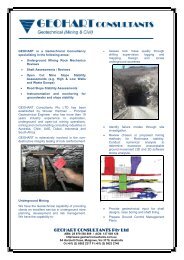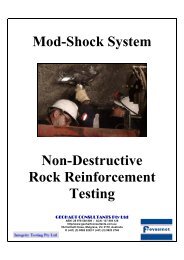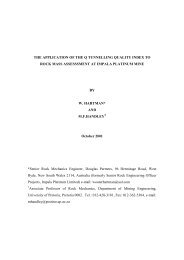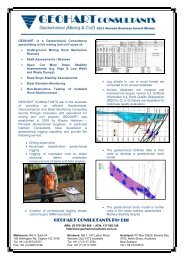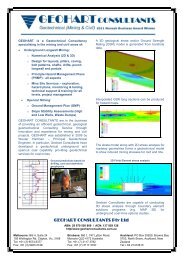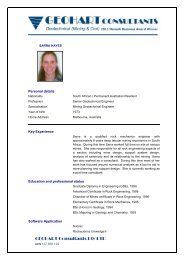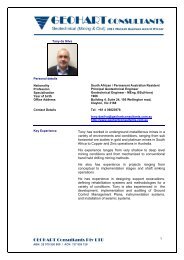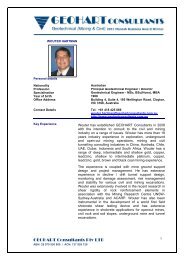Managing Geotechnical Risk through Non-Destructive Rock ...
Managing Geotechnical Risk through Non-Destructive Rock ...
Managing Geotechnical Risk through Non-Destructive Rock ...
You also want an ePaper? Increase the reach of your titles
YUMPU automatically turns print PDFs into web optimized ePapers that Google loves.
(i)<br />
Boltometer<br />
Instrument can be used on cemented grouted bolts and also on polyester and some other<br />
grouts. Buys found that the Boltometer can indicate bad ground, but if the impedance<br />
between the grout and surrounding rock are the same; wave energy will dissipate into the<br />
rock before it could reach a major defect, reporting good grouting.<br />
(ii)<br />
JK rockbolt tester<br />
Device developed by the JKMRC at the University of Queensland and is based on the<br />
measurement and analysis of the complete dynamic response of the bolt. The essence of<br />
the method is to measure the frequency response function of the bolt. This function can<br />
be considered as the signature of the bolt in situ. Resonant frequencies and associated<br />
damping ratios are primarily determined by the mechanical characteristics of the bolt in<br />
situ, resin grout and the rock.<br />
(iii)<br />
GRANIT<br />
The ground anchorage integrity testing (GRANIT) system was developed at the<br />
University of Aberdeen in Scotland. This testing system applies an impulse of known<br />
force by means of an impact device that is attached to the tendons. The vibration signals<br />
that arise from this impulse are complex in nature and require analysis to be performed.<br />
Novel artificial intelligence techniques are used in order to learn the complicated<br />
relationships that exist between anchorage and its response to an impulse. A single axial<br />
impulse load is generated at the head of the tendon. A set of datum responses signatures<br />
for different post-tension levels is recorded for the anchorage immediately after<br />
installation. The condition of the tendon at any later date can be determined by<br />
comparing the datum with the characteristics of the subsequent response signatures. A<br />
change in characteristics indicates a potential change in the integrity of the anchorage. It<br />
is difficult determining the relationship between the dynamic response of the anchorage<br />
and its post tension level. Therefore, neural networks are implemented, which suit the<br />
task of learning such complicated non-linear relationships. The neural network, trained<br />
on a single tendon, may be used to diagnose the post tension level of a number of<br />
tendons. The disadvantage of this system is that it can only work on rock bolts that have<br />
been charaterised at installation.<br />
5



